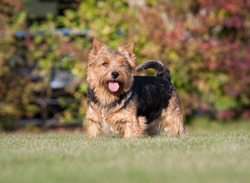Norwich Terriers are small dogs with a wiry, weather-resistant coat that comes in red, black and tan, wheaten, or grizzle. The coat is straight and lies close to the body, and these dogs have a definite undercoat. The hair on the shoulders and neck is longer and forms a mane. The breed's eyes are dark and oval, and the ears are pricked and medium size. Norwich Terriers should not measure more than 10 inches tall at the shoulder; the breed's ideal weight is about 12 pounds.
Norwich Terriers are a trainable breed, but they need a strong and consistent teacher in order to be successful when learning commands.
Loyal, amusing, and fearless, Norwich Terriers make great companion animals for families with older children. These dogs get along well with other pets, and they do best in active homes. The breed is known for its ability to adapt to new living conditions and changing situations, which makes it well suited for living in city apartments or rural homes.
The Norwich Terrier is very closely related to the Norfolk Terrier, but the breeds do have some notable differences. Norwich Terriers have erect ears, while the Norfolk Terrier has ears that fold forward.
Norwich Terriers are curious dogs with strong hunting instincts, which makes them unsafe around small animals, such as rats and rabbits. However, they typically get along with other pets and they do very well with children. Because of their high energy levels, these dogs are ideally suited to active families that spend a lot of time outdoors.
Happy, loyal, affectionate, and amusing, these dogs are perfect for people with a sense of humor and a love of active adventure. They require a good amount of exercise and should be taken for a walk or short run daily to prevent the build up of excess energy, which can lead to destructive and negative behaviors in this breed. The breed is very sociable and does not like being left alone for long periods.
Norwich Terriers make good watchdogs, but their barking can become excessive. Burning off excess energy through play will help. These dogs also excel at, and enjoy, agility, rally, obedience, tracking, and earthdog tests.
A fairly healthy breed, Norwich Terriers do not suffer from a great number of genetic conditions or health problems. However, this does not guarantee that any individual dog will be free of illness or genetic disorders. To help ensure a healthy dog, this breed should only be adopted or purchased from a reputable source.
Cardiomyopathy and breathing problems associated with a collapsing trachea are two of the more serious conditions known to affect this breed. Patellar luxation, which can interfere with mobility, and eye disorders such as lens luxation and corneal dystrophy are also more common in these dogs than in some other breeds. Some of these conditions are manageable with professional treatment.
With routine veterinary care, vaccinations throughout life, a well-balanced diet, and regular exercise, Norwich Terriers typically live up to 15 years.
Norwich Terriers are a trainable breed, but they need a strong and consistent teacher in order to be successful when learning commands. Unlike many other small breeds, these dogs are easy to housetrain, although the process may require some patience and time. Positive reinforcement techniques, such as praise, play, and food rewards, are especially effective when training this breed.
Much of the breed's negative behavior tends to stem from being ignored, bored, or neglected. In addition to training, lots of affection and attention and regular play sessions will help. Behaviors such as nuisance barking generally respond well to training and may never become a problem in dogs that begin training very early in life.
Socialization will help Norwich Terrier puppies grow into confident and tolerant adults. Throughout life, regular walks around the neighborhood, visits to local businesses, and trips to the dog park will ensure these dogs do not have the opportunity to become overly suspicious or fearful.
Norwich Terriers have a wiry coat that requires regular grooming, which includes brushing every other day and regular stripping every few months. Hand stripping is a time consuming process that is best done by a professional, but it can be learned and performed at home. It involves pulling dead hairs from the coat with a stripping knife. Stripping will reduce shedding.
Bathing should only be done when necessary, because soap will reduce the weatherproofing properties of the breed's coat. A stripped coat is water resistant and sheds dirt easily, and therefore only needs bathing when these dogs roll around in a harmful substance. Coats that have not been stripped may need more frequent bathing, but it is still rarely necessary.
The teeth should be brushed daily using a canine toothpaste and toothbrush, and the nails needs trimming every couple of weeks to prevent snagging and breaking. Additionally, weekly ear checks are important to look for excess wax accumulation and signs of infection.
Norwich Terriers were developed in East Anglia, England as barnyard ratters. They excelled in this role and were also used to flush fox and other vermin from dens during hunts. Norwich Terriers worked well alone and in packs.
Originally, the breed had two ears styles, pricked and hanging ears. In 1979, dogs with drop ears officially became a separate breed, now called the Norfolk Terrier. Dogs with prick ears became known as Norwich Terriers. The two breeds are still frequently confused because of their very similar appearance and personality.
Today, these dogs are primarily kept as companion animals in family homes. In some rural areas, they may still function as ratters.
The Norwich Terrier was officially recognized by the American Kennel Club in 1936.

